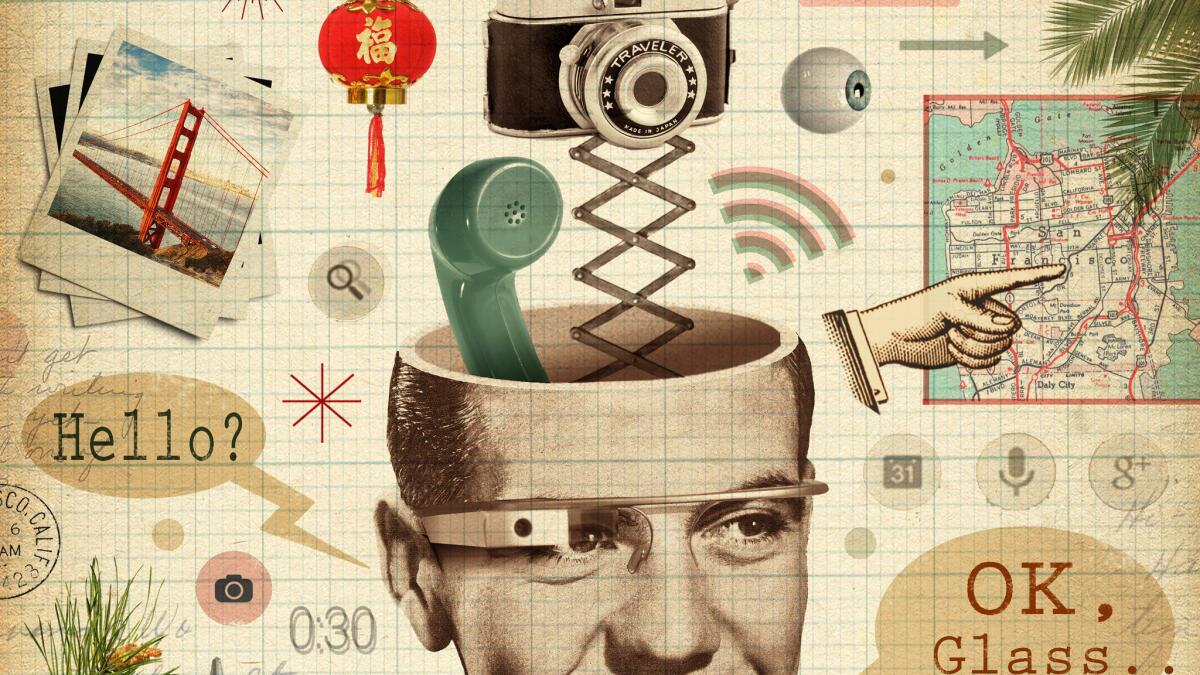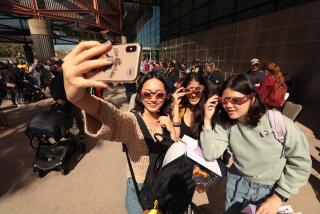Looking at San Francisco through Google Glass

After you slip on Google Glass — the new computer you wear on your face — you get things rolling with the voice command, “OK, Glass.” Then you tell the eyeglass-like contraption what you want it to do — take a picture, shoot a video, give you directions, tweet and more.
When I experimented recently with Google Glass in the City by the Bay, my second command was this: “OK, Glass. Help me see San Francisco through new eyes.”
S.F. and I have a sometimes-less-than-OK relationship, mostly my fault (thanks to traffic tickets, romantic weekends that weren’t, body parts that malfunction), not the city’s (except for that epic rainstorm two years ago, not that I’m bitter).
But it’s also a familiar place that offered a basis of comparison to help me see how well this titanium-framed little tech wonder would work and whether it could change a traveler’s perspective. Nob Hill’s Stanford Court hotel was offering a Google Glass package that allowed a tryout without laying out $1,500 for something I wasn’t sure about.
My experience with Glass? Just OK.
I’m neither a techie nor a quick study. I use PCs and an iPhone (Glass is an Android device), and I think I know more about technology than I do, so I am grateful for electronics that don’t require a PhD to operate.
Glass didn’t require a doctorate, but it did take a bit of explanation, which is why I visited Google Base Camp in Venice for a demo beforehand. There I learned that I needed some extra gear and other apps to get the most use out of Glass. (See below.)
Even with that grounding, it wasn’t always easy to make Glass bend to my will, despite the voice command and the tap-and-swipe-the-temple-touchpad feature (the mouse, as it were). I sometimes found myself swiping when I should have been tapping and vice versa. More user time might have solved that problem. The little screen above my right eye wasn’t always easy to read, partly because I wore Glass over my glasses.
With experience, I might become a convert, even though I don’t think Glass, which was offered for sale online starting in April, is ready for prime time. Still, by the end of my Bay Area stay, I was swiping and tapping, photographing and videoing like a semi-advanced amateur.
Thanks to my quest, I had a chance to enjoy again the Exploratorium museum, Lands End and the Conservatory of Flowers on a beautiful summer day. A nighttime bus tour that wound through the city let me see the Bay Bridge from Treasure Island just as the sun was dancing off to bed.
I captured some of it on Glass, some with a point-and-shoot camera and some with a single-lens-reflex camera. Which was best? You can judge the results in the photo gallery below.
Perhaps the best travel use of Glass occurred on Sunday morning as I walked down California Street to Old St. Mary’s Cathedral. The Field Trip app offered quick lessons in history and architecture along the way. Inside the church, I violated etiquette by using Glass — forgive me, Father — to photograph and take video of the interior, but I will treasure those visual mementos as reminders of an uplifting Sunday message.
In the end, the message of my Glass experience was better than the experience itself: Try something new. Change your perspective. Don’t be afraid to fail. It’s rarely fatal.
More than OK, Glass.
_______
Google Glass can be useful in travel
Can Google Glass transform the way we travel? Maybe — or it could be the 2014 equivalent of theMicrosoft Zune, an iPod competitor that seemed like a good idea at the time. For travelers, Google Glass has some advantages that may elevate it. Among them:
— It is hands-free. No fumbling with your camera (or smartphone) and missing that great shot. The 5-megapixel camera and the 720p video can be activated with a voice command, a touch of the finger or even a wink.
— It can help explain the world around you. The Field Trip app is helpful in telling you what you’re seeing. It also can read that information to you.
— It can direct you to places you want to go. Maps (Google Now), directions (Compass app), restaurant reservations (Open Table and kosher restaurants with Jewish Guide for Glass) are at your fingertip.
— It can translate (menus, street signs) with the WordLens app.
— It can improve your golf game (Swingbyte app)
— It can keep your travel plans straight (TripIt app).
You can do all of these things with your smartphone. Do you need Glass? I claim no special vision, literally or figuratively, but I never thought an iPad was mandatory either — till I had one.
_______
Google Glass: Pros and cons
Here’s some of what wowed me or annoyed me in my two days with Google Glass:
Pro: It gives you a sense of freedom, as though there’s no limit on what you can know or find out. You can Google (natch!) when you’re out walking. Need a number for a cab? Just Google it.
Con: You can do the same with your smartphone. To make Google Glass work, you must have a Wi-Fi connection. I carried a Wi-Fi hotspot in my pocket (instead of converting my phone into one). It worked, except at Lands End where I lost the signal.
Pro: Glass is designed to be used in short bursts. Like a smartphone, its power should last all day if it’s used correctly.
Con: I was using it intensively. Glass is a bit of a power hog. By the end of 90 minutes in the Exploratorium, it was only 57% charged so I took a “juice break.” At my second stop, I had to plug into my reserve batteries (one for Glass and one for my hot spot).
Pro: The frame on Glass is adjustable and so are the nosepads.
Con: I was wearing glasses so I had to layer Glass on top of my glasses. Every time I adjusted either, the camera lens seemed to shift slightly on this 1 1/2-ounce device.
Pro: Accessing information through the Field Trip app was like having a little tour guide on your face. You can hear it or read the info on the tiny Glass screen.
Con: If you’re in bright sunlight, it’s hard to read or see what Field Trip is showing you. If it’s noisy, you won’t be able to hear what it’s telling you unless the earbud is in.
Pro: You can easily make calls. No more walking around with a phone glued to your head or a Bluetooth device sprouting from your ear.
Con: None. At first, I thought the call reception was bad. It wasn’t. What I thought was static on a call to my sister was the crowd roaring as she cheered on the Orioles at Baltimore’s Camden Yards stadium.
Pro: Glass’ still camera and video camera free you to capture a split-second moment in a way that a handheld camera can’t (or, at least, can’t for me).
Con: You must learn exactly where Glass’ camera lens is pointing. Framing a photo isn’t always easy.
Pro: On a night bus tour of San Francisco, Glass was the only thing that was warm.
Con: Under regular circumstances, Glass felt a little toasty on my right temple.
_______
Google Glass: Some things to know before using it
To make Google Glass work effectively, here are some things you need to know:
— It’s a good idea to schedule a demo before you set out on your own with Glass. The Stanford Court hotel handed me a bag that contained, besides the device, some brief instructions. You’ll probably want more. You can schedule an appointment at Google Base Camp, bit.ly/1ncz7kc. There’s an office in Venice. And you can read through some of the FAQs, bit.ly/1jkmEjh.
— Have Gmail? Good, because that’s the email that works with Glass. Familiarity with Google Plus (plus.google.com) is a plus.
— You’ll want to install the Glass app on your smartphone beforehand. Once the app is installed, you’ll find a Glassware Gallery that lists what’s available.
— You can download your Glass photos easily by connecting its USB cord to your laptop. (I was carrying a MacBook Air and installed Picasa as another photo manager just to be safe, but all ended up on Google Photos.)
More to Read
Sign up for The Wild
We’ll help you find the best places to hike, bike and run, as well as the perfect silent spots for meditation and yoga.
You may occasionally receive promotional content from the Los Angeles Times.







